The world of birding is filled with challenging groups well known to all, birds like gulls, Empidonax flycatchers or cisticolas that require attention to the tiniest details in order to assign an individual to a specific species (if it can be done at all). Sometimes, however, the God of Birding gets bored of tormenting birders in this way (if I learnt one thing from reading about the gods of old it is that they have the attention spans of kittens on espresso) and instead throw in a group of birds, many of which look quite different, but make them all the same species. One such bird is the Collared Kingfisher (Todiramphus chloris).
The Collared Kingfisher isn’t the most widespread kingfisher in the world (a distinction that would probably go to the Common Kingfisher or the Pied Kingfisher), but it is close, ranging from the African coast of the Red Sea through to Tonga and American Samoa. They are predominately coastal in many parts of their range, and are known as Mangrove Kingfishers because of this in places. Across their range there are a large number of subspecies, 49 according to the Handbook of the Birds of the World, but as we shall see there is some disagreement about both subspecies and species limits.
Subspecies humii, Thailand. Image by JJ Harrison (Creative Commons, Attribution Share-alike).
Above we have an example of the species. The subspecies humii ranges from Bengal to Singapore. Like most of teh species the undersides are white and the upperparts are some combination of blue or green, in this subspecies more towards the blue. The supercilium (eyebrow) stops just above the eye (which the technical would describe as a supraloral stripe I guess), and the loral stripe through the eye is blue. Compare this to the next bird…
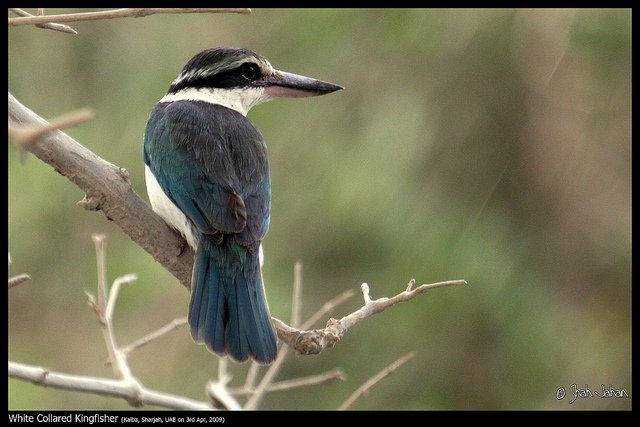
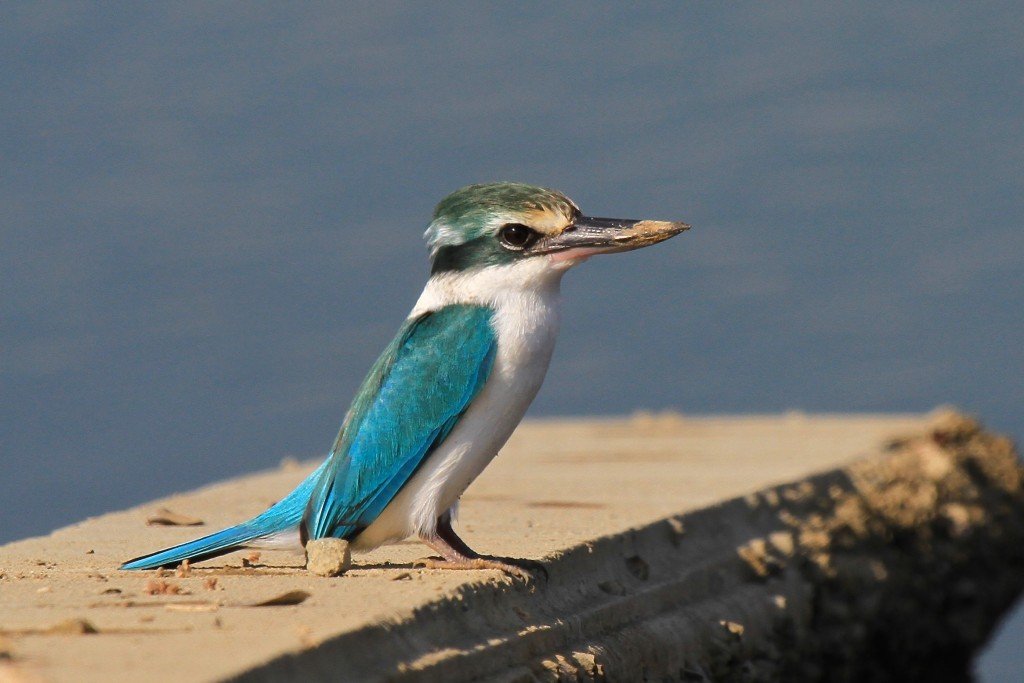 Subspecies kalbansis, United Arab Emirates. Top Flickr user Sjahanmi (Creative Commons, Attribution, Non-commercial). Bottom Tommy Pederson, used with permission.
Subspecies kalbansis, United Arab Emirates. Top Flickr user Sjahanmi (Creative Commons, Attribution, Non-commercial). Bottom Tommy Pederson, used with permission.
Here the white above the eye travels around the head (weakly) and the loral stripe through the eye is black (tinged with green). The two images show the difference lighting can make to the shades of blue and green in the back and wings. In the Indian subspecies vidali, the white doesn’t even reach the eye.
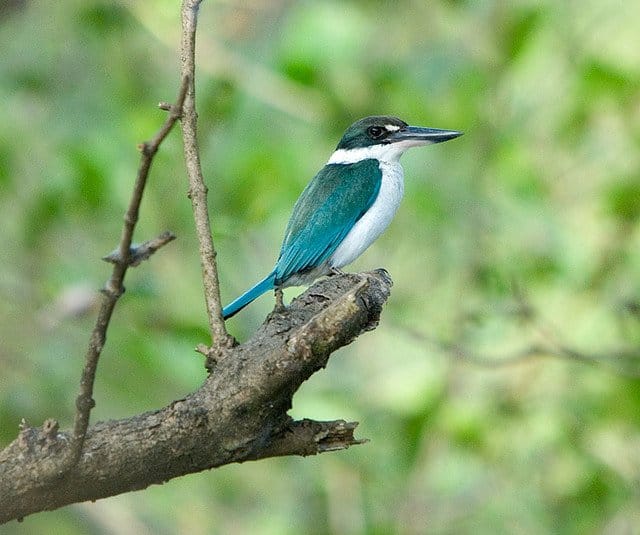 Subspecies vidali, Goa, India. Flickr User Sergey Yeliseev, (Creative Commons, Attribution, Non Commercial, Non-derivs)
Subspecies vidali, Goa, India. Flickr User Sergey Yeliseev, (Creative Commons, Attribution, Non Commercial, Non-derivs)
The Australian subspecies sordita has a similarly small patch of white, and a much darker head than the preceding subspecies. In Australia it is almost elusively found in mangroves, rarely away from the coast.
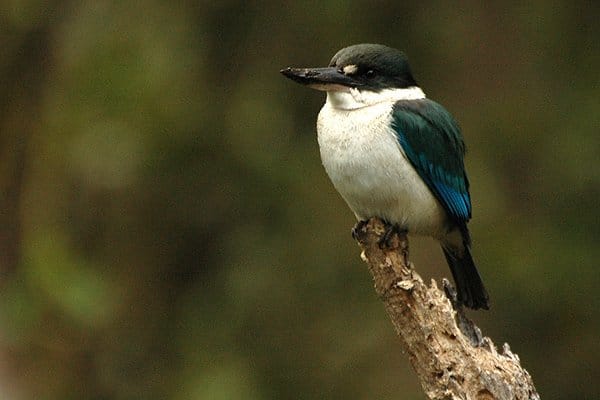 Subspecies sordita, SE Queensland. Tom Tarrant (Creative Commons, Attribution share-alike).
Subspecies sordita, SE Queensland. Tom Tarrant (Creative Commons, Attribution share-alike).
It’s when you start heading off into the Pacific, however, that you start bumping into the really unusual forms. It is also where the majority of subspecies occur. Vanuatu has five subspecies, Fiji has three, and the far flung Solomon Islands have twelve. The species is absent, however, from the neighbouring New Caledonia group; here instead you’ll find the closely related (and similar) Sacred Kingfisher, which also occurs in inland Australia and New Zealand.
It would be harder to get a stronger contrast to the dark headed Australian sordita than the form found on the Micronesian island of Saipan.
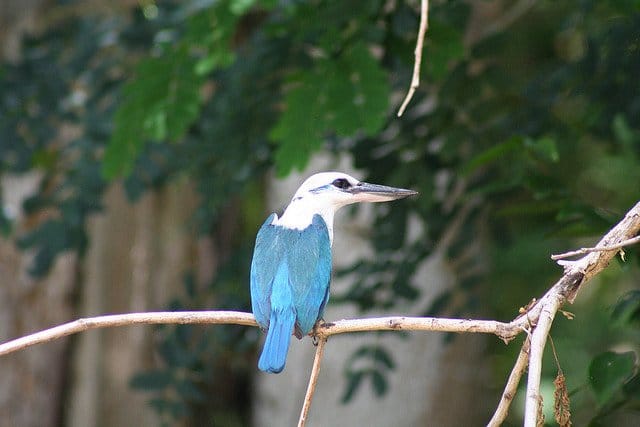
 Subspecies albicilla, Saipan, Micronesia. Flickr User Tropical Pete (Used with permission)
Subspecies albicilla, Saipan, Micronesia. Flickr User Tropical Pete (Used with permission)
The subspecies albicilla has an entirely white crown and the black loral stripe quickly narrows into a thin black nuchal line around the head. Almost six thousands kilometres away, on Tutuila in American Samoa, there is another population of mostly white-headed Collared Kingfishers.
Subspecies pealei, National Park of American Samoa. Bryan Harry, USNPS.
Here we see a crown that isn’t as white as the Saipan form, bit still much whiter than anything in Asia. Also we’re seeing some buff or rufous colouration in the white, something that varies not only by subspecies out in the Pacific but by sex. This subspecies, pealei, along with a number of other Polynesian races, are sufficiently different from other Collared Kingfishers (it seem to me that the bill is proportionally much shorter) that they are often thought to be better placed with the Chattering Kingfisher (Todiramphus tutus) of the Cook Islands and French Polynesia. Another race that might best be placed with the Chattering Kingfisher is the Tongan sacer.
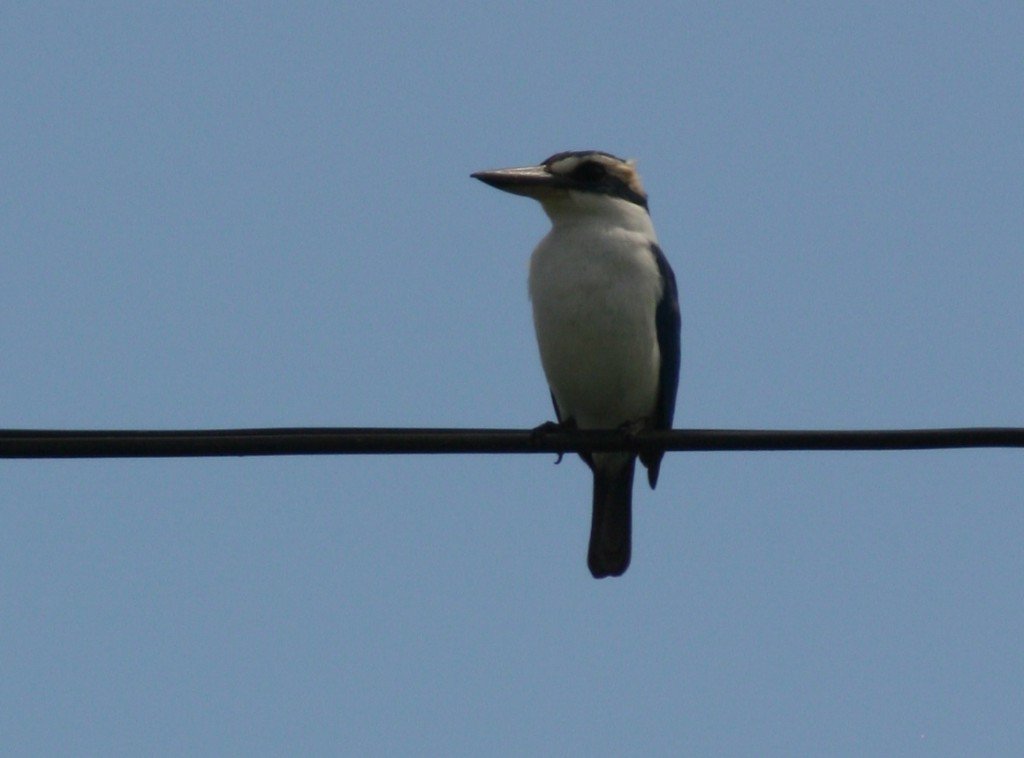 Subspecies sacer, ‘Eua, Tonga. Photo by author.
Subspecies sacer, ‘Eua, Tonga. Photo by author.
Not the greatest photo ever, but you can see it has a fairly wide white supercilium without being quite as white-headed as pealei or albicilla. Also a small amount of buff in the white as well. Moving back towards the continents we encounter one of the Fijian races, vitiensis. Here we can see a clear example of the sexual dichromism exhibited by some subspecies.
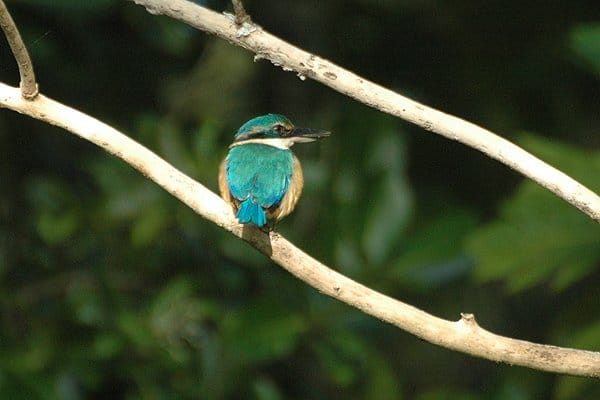
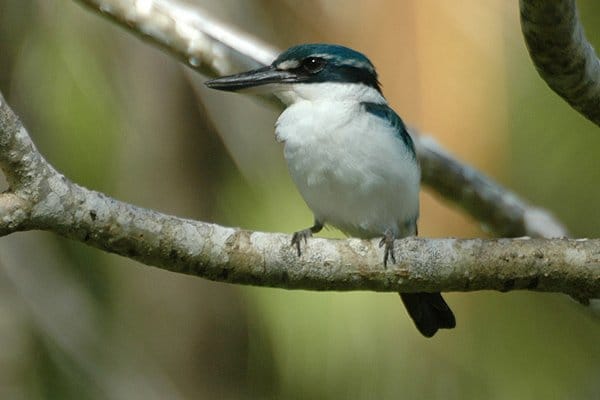 Subspecies vitiensis, female top male below. Tom Tarrant
Subspecies vitiensis, female top male below. Tom Tarrant
The extent of buff and rufous on Fijian birds has lead one author to place them with the Sacred Kingfishers instead of the Collared Kingfisher, even though there are none in Vanuatu (which is between New Caledonia and Fiji. There is also a kingfisher in Western Samoa, known as the Flat-billed Kingfisher, which is placed with the Sacred Kingfisher by the HBW, and treated as a species by others. Western Samoa, by the way, is similar to New Caledonia in lacking Collared Kingfishers, but smaller American Samoa has two subspecies. Just to make things even more confusing there is a race of the Chattering Kingfisher, ruficollaris, from Mangaia in the Cook Islands, which might also be placed with the Sacred Kingfisher. Moving further eastwards one finds a number of small and rare endemic species.
In short, there is a great deal of work needed in untangling the Todiramphus kingfishers of the Pacific, and plenty of potential for some student to come along and do some great work here (not to mention travel to some awesome places). I’ll leave you with the confusing bird that triggered my interest in this confusing species/species complex.
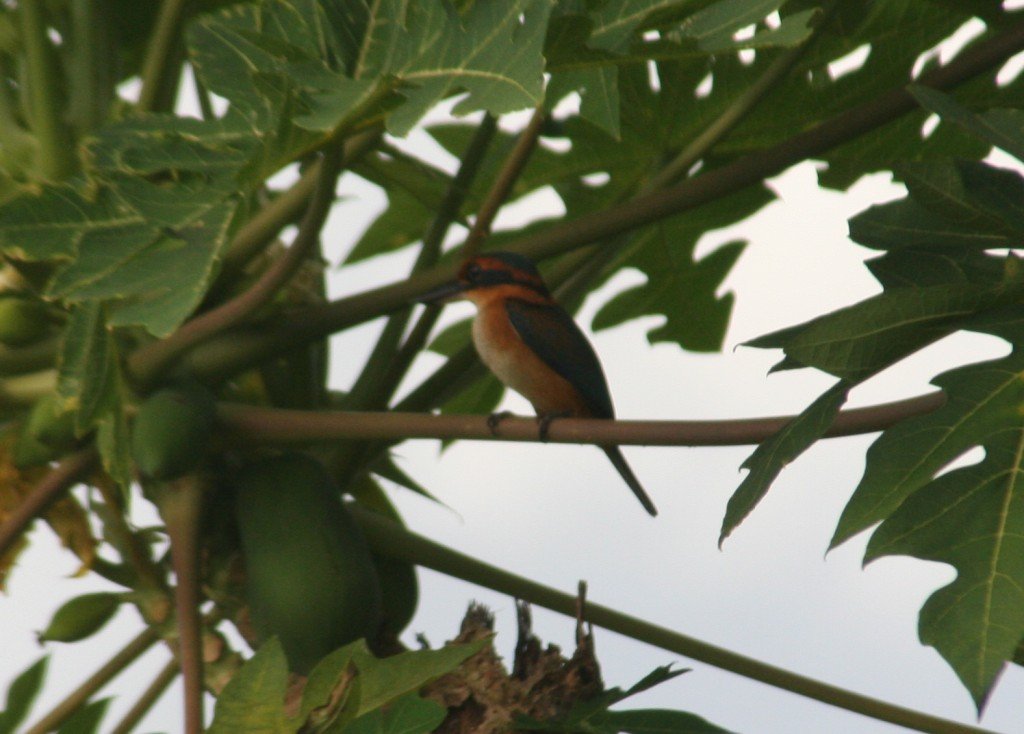 Subspecies juliae, Espiritu Santo, Vanuatu. Image by author.
Subspecies juliae, Espiritu Santo, Vanuatu. Image by author.
I saw this kingfisher on a trip to the largest island in Vanuatu, Espiritu Santo. The island has two species of kingfisher, the endemic Vanuatu Kingfisher (Todiramphus farquhari), which has a chestnut belly and flanks but an entirely white collar and no eyebrow stripe, and one of the whiter subspecies of Collared Kingfisher (santoensis, which I saw plenty of). This guy, on the other hand, had a rufous collar (rendering the other common name for this species, the White-collared Kingfisher, incorrect), a rufous supercilium and flanks. I had to ask for help with this one, and a friendly Flickr commenter, Cuckoroller, explained that it was a vagrant. Collared Kingfishers in Vanuatu get more buff and rufous as one moves south, and this was an example of juliae, from the middle of my chain. My HBW actually illustrated this subspecies but made it much more white, but Cuckoroller explained that they are sexually dichromic and that the males tend to be more rufous. The combination of multiple subspecies, inconsistent patterns of sexual dichromisim, closely related similar looking species and a general lack coverage in common guides all combine to make the Collared Kingfisher one of the more confusing, but interesting, species I have ever encountered.
…
If you liked this post and want to see more great images of birds make sure to check out 10,000 Clicks, our big (and growing) page of galleries here at 10,000 Birds.

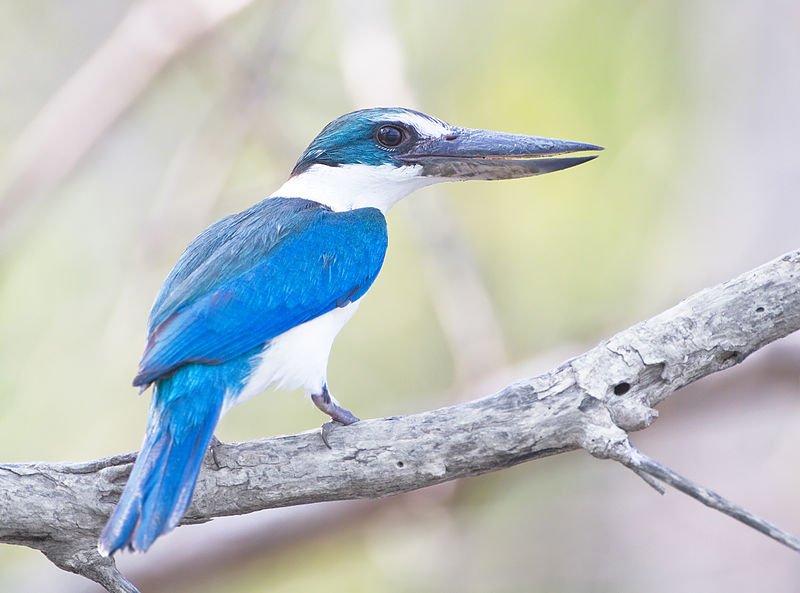
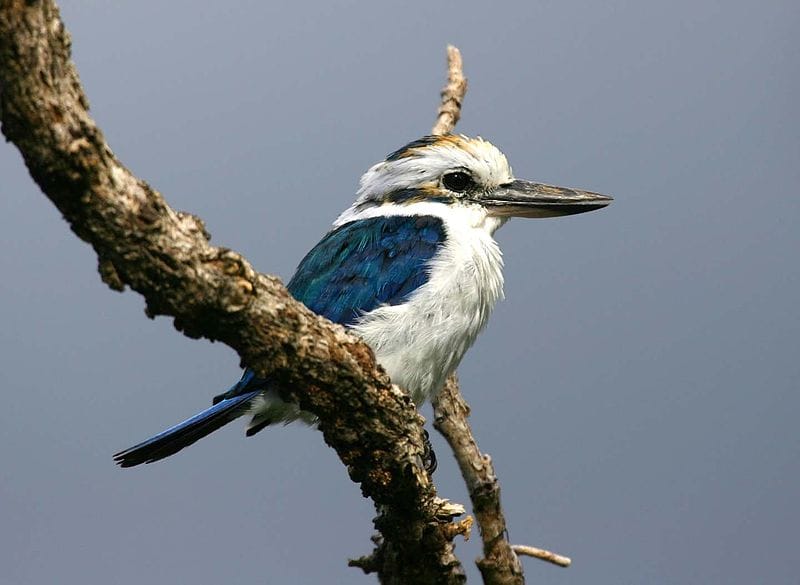










Phenomenal resource, Duncan. The variability of this one species boggles the mind. Thanks!
Duncan, did I ever mention that I love gulls for the simplicity of their taxonomy and identification?
Geez *sweats, huffs & puffs*
🙂
Thanks. I wish I had been able to get some images from the Solomon Islands and taken some of the other Collared Kingfishers on Santo.